
|   |

|   |
 e-mail: sunilkothari1933@gmail.com Nrutya Rangoli Samanvay Art Festival: Part 2 Photos courtesy: Samanvay May 11, 2019 Nrutya Rangoli Samanvay Art Festival: Part 1 On third day, the morning session began with Kuchipudi by Dr. Saraswati Rajathesh. She presented Vempati Chinna Satyam's choreography of his popular "Jayamu Jayamu" in Bilahari raga, set to music by Bhujangaraya Sharma, with nattuvangam by Vempati Ravi. Disciple of Veena Murthy, despite avoirdupois, she was light on her feet. 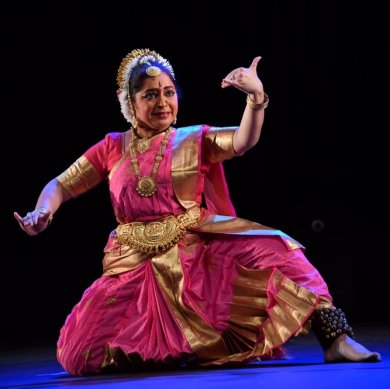 Saraswati Rajathesh Shivashtakam in praise of Lord Shiva, "Gale rundamala, kapalam vipulam, trinetram, smashane vasantam" etc epithets came tumbling down in great speed, in performance of two young dancers who left much to be desired in terms of angashuddha. The three tiny tots were charming. "Muddugare Yashoda" of Annamacharya always has instant appeal for its vatsalya bhava and Krishna's pranks, mother's love for Krishna. It is a shared tradition and is a favourite of dancers. The highlight of the session was Nayaka Vilasa, 4th edition of Creative Lab. In this session six male dancers were assigned challenging task of interpreting women's feelings. Gururaju, a disciple of Vyjayanthi Kashi, in Kuchipudi had to display swadhinapatika nayika in Kshetrayya's padam, "Entha chakkani vaade naa saami." The sakhi asks the nayika about her husband. The nayika describes the greatness of her lord - he is full of valour, his waist is slim like lion's, hands are long like the trunk of an elephant, and so on. The panel included Dr. Shadakshari, Sandhya Kiran, Prof. Sudhir Kumar and myself, moderated by musician / Sanskrit scholar T.S Satyavathi. I observed that the challenge lay in not to look effeminate, remain masculine as nayaka, but emote feelings of nayika as expected taking the padam as a take-off point with sanchari bhavas. Gururaju enacted abhinaya with restraint and with suggestive sanchari bhavas without exaggerating emotions. Dr. Shadakshari, Sandhya Kiran and Prof Sudhir Kumar agreed that he did not look effeminate but as a swadhinapatika nayika he had to display certain arrogance. Else his performance was laudable. 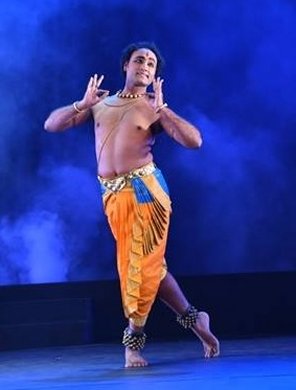 Gururaju 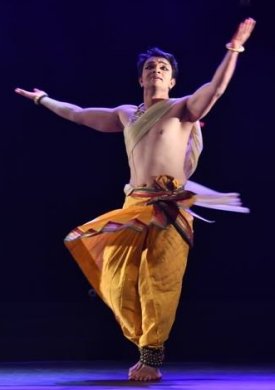 Nidhaga Karunad Nidhaga Karunad, disciple of Articulate Nataraj, performed the theme of Radha Bhava Madhav, asking Krishna to become Radha to understand Radha's feelings for Krishna. Nidhaga used scarf to suggest Radha taking ghunghat, and turning it and draping around shoulders to suggest Krishna. Taking palta using gat bhav, he enacted Radha waiting for Krishna, not turning up on appointed time, and was khandita when he turned up to reconcile with her. Radha does not reconcile and punishes him to turn Radha. Nidhaga enacted the movements of putting on ornaments, sari and performed gat with grace as Radha, the incorporated sanchari of vasaksajjika nayika, and then abhisarika, facing all the hurdles of rain, lightning, serpent crossing the road, animal frightening her and rushing to meet Krishna dressed as Radha. It was interesting the way he used the scarf for Radha and Krishna. He used Kathak technique well using tatkar for rain, showing lightning, serpent et al. I felt that despite competent communication, in the end he rushed through and should have shown meeting of Radha and Madhava. There was an overlap of virahotkanthita and khandita nayika in his depiction. Though he used Kathak vocabulary well he should have in the end enhanced the Radha Madhava bhava emphasis by their meeting. The others also observed that he could have displayed the two aspects distinctly. Prabal Gupta, disciple of Sadanam Balakrishnan asan since 2010, has matured a lot. He was the only male dancer who had put on stree vesham to enact the story of Kacha Devayani. Prabal has a mobile face and large eyes, which speak and register expressions well. He avoided kalasam in order to perform within the allotted 10 minutes. He explained the story of Kacha and Devayani and how after Kacha was cut into pieces and mixed with drink swallowed by Sukracharya, with 'Sanjivani mantra' he was brought back to life. Devayani, who fell in love with him, begs of him for love making which Kacha does not submit. Prabal as Devayani as happens in Kathakali for enactment of female roles by male dancers, succeeded in transforming into the female role His abhinaya was perfect for kamakeli using matsya mudra, eyes beseeching union with Kacha, asking him how he could forget the three years of their intimacy and love. His cry, "O Paurushmani, can you not see my agony, O pranasakha?" came loud and clear. When questioned why he put on female costume, he said that he was asked to put on for Kathakali style. On the whole, all panelists appreciated Prabal's presentation. Dr Satyavathi was very pleased because she had not seen such a theme in dance. 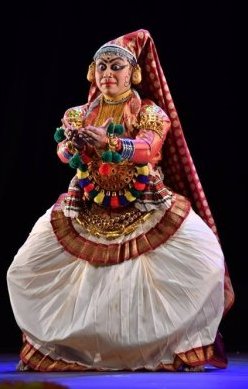 Prabal Gupta 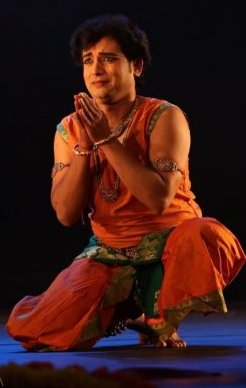 Somashekar Somashekar Chudanath, a disciple of Suparna Venkatesh, in Bharatanatyam selected ashtapadi from Gita Govinda, "Radhika tava virahe dina." Sakhi watching Radhika's state separated from Krishna, suffering, drawing his name on ground, removing chandan which she applied earlier as now it pains her like poison, the garland feels heavy, everything she had planned has now turned against her... she begs of Krishna to go unto Radha. Somashekar had a bigger challenge to enact suffering of Radha, which as Sakhi, she has to tell Krishna. Alternating role of sakhi and describing Radha's anguish, Somashekar did a commendable job. The intensity was brought out well. Even in sanchari picking up dust from ground and showering on Radha's body was very touchingly depicted. Sandhya Kiran mentioned that since she knows him too well, she had problem seeing him as sakhi, and was often reminded of him as Somashekar. I observed that complete immersion in the role as we all have seen in abhinaya of Kelucharan Mohapatra - when he acts as Radha, we completely forget his persona - is not easy to achieve. Somashekar did his best in two characters. Even when we know a dancer personally very well, as a spectator we have to overcome our familiarity with him and see objectively how he performs. 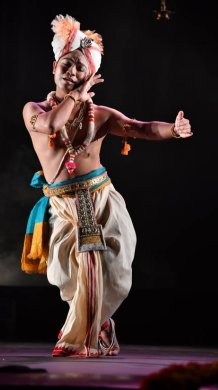 Sinam Basu The most difficult task was for Sinam Basu, the talented Manipuri exponent, who attempted for the first time "Kuru yadunandana" ashtapadi in Manipuri dance. So far it has never been attempted. Manipuri deals with bhakti shringara, which is expressed through angikabhinaya. There is little mukhajabhinaya to express shringara as one sees in other dance forms - quite in contrast to Kathakali where mukhajabhinaya is loud and clear. Sinam Basu with guidance of his Guru Tiken Singh and suggestion from Amusana Devi, a senior Manipuri dancer, with restrain and suggestion brought out the shringara rasa with which the ashtapadi is replete. The references to applying chandan on her breasts which are like 'mangalakalasa sahodare', two pitchers, had to be depicted with simple hand gestures close to chest. 'Ratigalite lalite kusumani', placing flowers on her hair which were displaced during the love play, putting kajal on her eyes which was smudged, and placing waistband around her waist et al were so delicately performed in typical Manipuri lasya form, that one marvelled at his ability to stick to the dance form and within the tradition bring out the essence of the ashtapadi. The traditional Manipuri music was rendered with emotion matching the feeling. Alternating between two roles of Radha requesting Krishna to decorate her once again after the love play and Krishna obeying her command and placing the flowers etc, was performed with restraint. Even though not as familiar with Manipuri tradition as few Manipuri performances are seen in Bangalore, the connoisseurs and the rasikas enjoyed Sinam Basu's presentation. I consider it as one of the best as such an attempt is courageous and within tradition. Sinam has been working on themes besides predominant Radha Krishna themes. He mentioned to me later that he wants to attempt ardhanarishwara in Manipuri as he can use both tandava and lasya aspects in the depiction. All the panelists agreed that all dancers had done justice to what was a difficult task. Such attempts on part of Creative Lab are most welcome. Congratulations to all participants and their gurus. 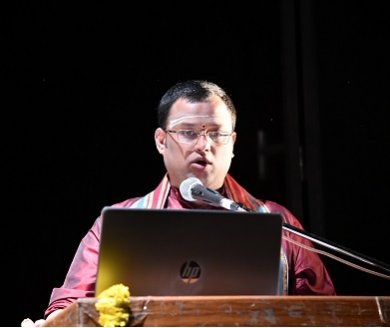 Dr. Tadepalli 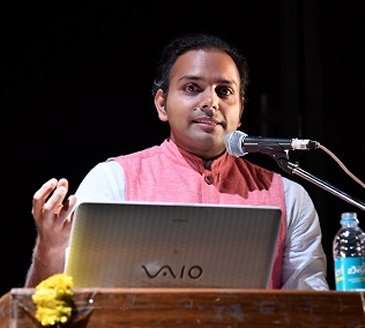 Keerti Kumar After this exquisite session, Dr. Tadepalli gave an erudite talk on Chaturvidha abhinaya by male dancers in Kuchipudi Yakshagana, showing rare vintage dance clippings of Vedantam Satyam, conversations with Swapnasundari explaining her role of Jada in Kuchipudi and dealt with four types of abhinaya. One more talk was by Keerthi Kumar on lighting and multimedia. It was indeed very illuminating touching upon various aspects when using multimedia when lighting should allow the graphics used and not overshadow. Also he spoke on the use of various lights and its effect upon the costumes and backdrop. These were valuable suggestions. My only regret was that since it got delayed and the session ended at 2pm, there were few in the audience to benefit from such welcome talks. One admires Veena Murthy's Herculean efforts to rope in so many people in this festival. But even on Sunday, the morning session drew thin audience and since the proceedings got delayed, many rasikas left. However the concluding evening session was another highlight of the festival. To encourage young talent, Rajendra and Nirupama's disciple Srividya N Bhardwaj was presented in Kathak. Beginning with prayer in Sanskrit on Krishna with description of 'supiccha guchha mastakam,' peacock feather adorning as crown on his head, Krishna holds 'sunada venu hastakam,' melodious flute in his hands, and is an ocean of beauty, 'anang ranga sangaram.' Srividya at once established herself as a well-trained dancer. The following nritta with parans, gat, and tatkar were all centered on Krishna's pranks and were performed in a seamless manner. The ashatapdi "Lalita lavanga lata" displayed Radha's despair watching Krishna dancing with other Gopis on the bank of river Yamuna when spring was in full bloom. The virahotkanthita state was depicted with emotions befitting Radha. The finale with Amir Khushro's tarana in Darbari was replete with joyous abandon and the salutation, salami was in order with performance in a court creating right ambience. The tarana was embellished with tode, tukde and also gat. Srivdiya received appreciative applause for her performance. She did her gurus proud. Shatavadhani Dr. R.Ganesh, the redoubtable scholar gave an extremely enjoyable discourse on Navarasa. Scholarship sits lightly on his shoulders. Extremely humble and polite, his presence and narrative lifted the mood of the evening. Bhava, anubhava, 'rasayanti iti rasa' and giving examples of what is 'anauchitya', inappropriate when depicting rasa like karuna and resorting to krodha, which are poles apart were quite revealing in terms of what dancers need to be aware of. 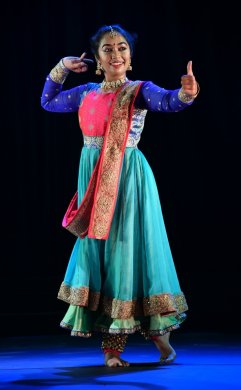 Srividya N Bhardwaj 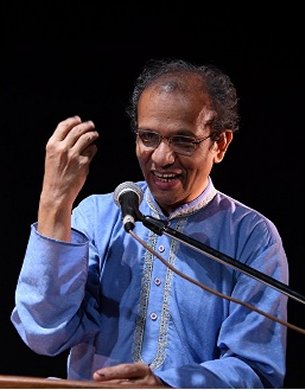 Shatavadhani Dr. R.Ganesh 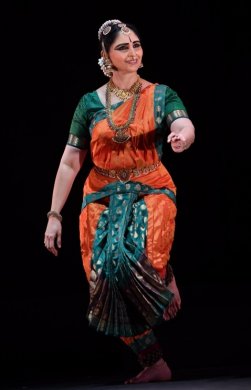 Soundarya Igoor  Parshwanath Upadhye Then followed 'Navarasas by Navarathnas.' Soundarya Igoor in Bharatanatyam using a javali depicted sringara delineating eight states of a nayika with consummate artistry. The emotions were at her beck and call. Expecting the arrival of nayaka, she puts on ornaments, prepares bed with flowers, scent, but when he does not arrive, she is virahotkanthita, removes all her ornaments, cannot eat food which appears like poison, and when nayaka arrives late she accuses him, shows him how she had prepared bed with flowers, even the flowers had faded, taunting him about the love play, and tells him to go away, recalls he had gone astride horse and she was in a state of proshitabhartrika. When he returns, she is still angry, removes his hands when he embraces her, calls him 'nishthur,' heartless, folds her palms and asks him to leave. Then repents as a kalahantarita nayika, why did she quarrel with him and he left her. If he returns she would ask his forgiveness. Then overcoming her pride she decides to go unto him as vasakasajja, and suggest happy union. Soundarya carried off the various states of nayika in a seamless manner. The support by seasoned musicians, her husband Srivatsa on vocal and others Jayaram Kikkeri, Hari Karthik, Dayakar helped her lift the performance to artistic heights. Parshwanath Upadhye chose hasya rasa. A versatile Bharatanatyam dancer, he has established himself as a resourceful, imaginative and excellent dancer. The theme he chose was Kamadeva with his arrows visits Himalayas, abode of Lord Shiva, and watches Ganapati walking around. Kamadeva starts throwing his arrows, which do not bother Ganapati and he ignores them. He picks up the arrows and breaks them and laughs at Kamadeva's attempts. Kamadeva then moves to Brindavan where Gopis are fetching water. He plans to plunge into water and enjoy swim, when Gopis decide to steal his clothes and hide them. Krishna is playing and sees bees hovering over flowers, moves happily, and then discovers that his clothes have been stolen by Gopis who wish to punish him, as he had stolen their garments and asked them to stand out of water naked before him. But Krishna comes out of water courageously naked and the Gopis are embarrassed. They throw his clothes quickly and run away. Krishna puts on his clothes and plays upon flute victoriously. Two years ago, I had seen Parshwanath performing this number in the morning session in the dance festival of The Music Academy in Chennai winning rounds of applause for his abhinaya and excellent technique of Bharatanatyam. Somehow in this performance, it did not generate the expected laughter with an impact. He could have selected another episode for hasya rasa with which he could have with his reputation as a brilliant dancer entertained the audience who were expecting surprise from him. Madhulita Mohapatra, the Odissi dancer now settled in Bangalore for a decade, has earned appreciation of Bangaloreans. She selected karuna rasa for delineation. Taking the story of Satyavan and Savitry, she dwelt upon her love for Satyavana even when she knew that his life was limited and Yama would take him away. Seeing him dead, she cries and asks him how he could leave her. Does he not remember the wonderful time they had spent together? The time they spent in full moon night, in garden and now she finds him gone. Her agony and pain know no bounds. Performing to the lyric written by Odiya poet Kedar Mishra in Odiya language, which was alternatively spoken in English by Meghna Das, and set to music with vocal by Akila Venkat, mardala by Soubhagya Narayana, flute by Jayaram Kikkeri and violin by Mysore Dayakar, it had Odissi flavor with an interesting interlude of pure dance of a pallavi. However, those who know the full story are reminded of Savitry's cleverly asking boon from Yamaraja when he sees her abiding love for Satyavan. Since she could not ask for his life, Savitry tricks Yamaraja by asking herself to be a mother. Yamaraja gives the boon and Savitry asks Yamaraja how can she be a mother when she is a widow as Satyavan is dead. Yamaraja revives Satyavan and they live happily. This story one remembers watching the performance and sympathizes with Savitry's plight. Therefore, focusing on her lament on Satyavan's passing away only for karuna rasa does not create necessary impact. The partially selected theme for me, at least, did not jell for karuna rasa. Followed like a storm for depiction of raudra rasa, Pavitra Bhat, disciple of Deepak Majumdar from Mumbai, in Bharatanatyam enacting four characters of Narasimha, Parashurama, Bhima and Lord Rama. Saving Prahalada, his devotee from the wrath of Hiranyakashipu, as Narasimaha, Pavitra wore terrific expression killing the demon with flawless Bharatanatyam movements. In quick succession like Parashurama, angry and killing kshatriyas, he ran across the stage, turned into raudra Bhima and killed Dushasana, taking his entrails and applying his blood to hair of Draupadi and finally as Uttama nayaka Lord Rama, how he took his bow to kill Ravana aiming his arrow at his naval where 'amrita kupi' was to be broken so Ravana would die. Pavitra's utplavana and entire frame agog with power and feeling of raudra rasa created magic. Here is a dancer one has to take note of for his excellence both in nritta and abhinaya. The musicians helped him also to generate feeling of raudra rasa. He won appreciation of audience. 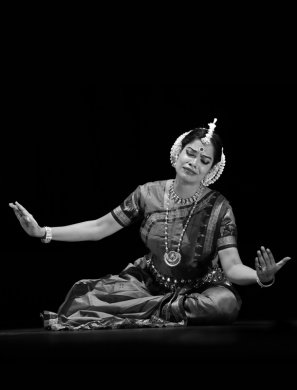 Madhulita Mohapatra 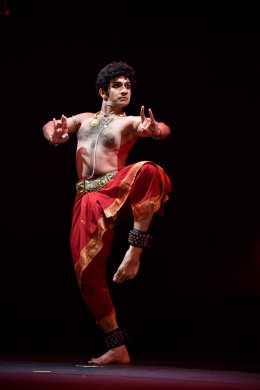 Pavitra Bhat 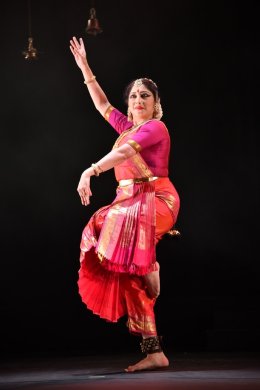 Lakshmi Gopalaswamy 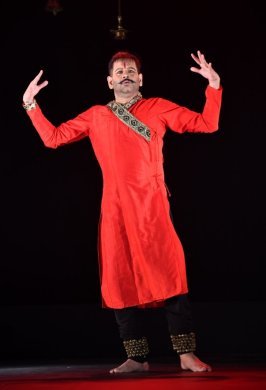 Murali Mohan Kalva Lakshmi Gopalaswamy in Bharatanatyam took an altogether different view of veera rasa. If one goes beyond fear and expresses his complex is he not a veera? She took two instances to illustrate her view point. A king sends his warriors in front and hides behind them in a war, and then confesses his cowardice; to have courage to confess, is it not veeratva? Another example of a greedy woman who accepts ornaments from a nayaka, promises love, has love play and runs away with all ornaments, but when caught finally accepts her crime of stealing and apologizes. Overcoming her guilt she confesses and begs forgiveness. Is not that veeratva? Soldiers who die for matrubhumi of course are full of veeratva. I had seen Lakshmi perform this in Navarasa conceived by Priya Murle for Natya Darshan festival in December in Chennai. She is a versatile artist and courageously put across her point of view of what is courage. Her presentation during this session was equally gripping. Murali Mohan Kalva is a seasoned Kathak exponent and a well-known name in Kathak circles in Bangalore. He had returned only a day or two before and was given bhayanaka rasa. He consulted his colleagues musician Praveen D Rao for tabla accompaniment and vocalist Samanvitha Sharma, selecting the theme of how Lord Narasimha saved Prahalada. Even when Hiranyakashipu unable to bear Prahalada's singing 'Narayana Narayana' took him to the top of a mountain and threw him deep down, the lord received him in his hands. Demon decides to place him in lap of Holika and see him burn, but the fire was doused and he was saved. The refrain "Meri bhi suno nath sab ke bhaya nivare" - listen to my prayer, O lord, you have removed fear of your devotees, save me. To the melodious aalap by Samanvitha and tabla accompaniment by Praveen D Rao, Murali Mohan taking gat further developed the story of Sita being kidnapped by Ravana in guise of a mendicant. Murali Mohan performing gat, brought a refreshing touch of upaj, spontaneous improvisation; when turning into mendicant, he pressed his other nine faces into one and became a sadhu asking for bhiksha. A clever ploy and an imaginative touch. The final scene was of saving Devaki and Vasudeva from King Kamsa, who knowing that the eighth son of Devaki would kill him put Devaki and Vasudeva in jail and one after another he killed their seven children. Devaki was scared when the eighth child was born. And lo and behold! The guards were found asleep, the doors of jail were open. Vasudeva took the child and placed him in basket, but the rain started and turned torrential, he had to cross river Yamuna and what did he see when he looked below, the shadow of Sheshnaga as a chhatra over him and his child, and he could leave Krishna in Yashoda's home. That was an imaginative touch. The refrain "Meri suno nath sab ke bhaya nivare" brought the performance to end. Murali Mohan succeeded in portraying the episodes for bhayanaka succinctly. The musicians gave him excellent support. Anuradha Vikranth, a celebrated Bharatanatyam dancer, disciple of Guru Narmada and Nirupama, with guidance of Dr R, Ganesh selected adbhuta rasa for presentation. Krishna and Yashoda and the miraculous deeds of Krishna were pinpointed. Listening to Krishna's flute, nature animals, birds, all are mesmerized. Begetting Krishna as a son, Yashoda, churning butter, calling Krishna with vatsalya bhava asking him to give her a kiss, running after him playing with a ball, his dancing like a peacock, his dance in navatala, and then he disappears. Yashoda asks one and all if they have seen her child. She sees him eating earth, and runs unto him to chide him. She asks Krishna to open his mouth and is wonderstruck seeing the entire universe in his mouth; she realizes that her child is divine and bows to him. The depiction of wonder was performed with alacrity, spontaneity, and finesse. 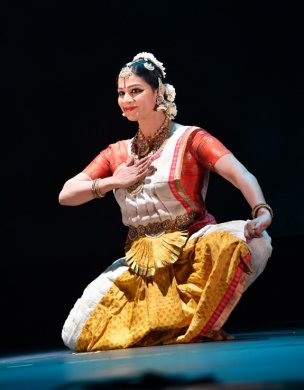 Anuradha Vikranth 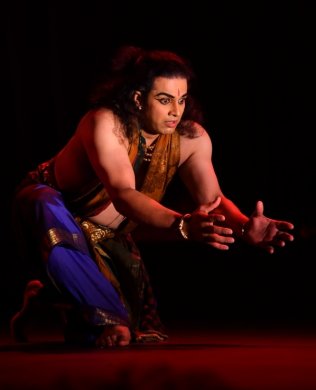 Surya Rao The final rasa was bibhatsa performed in Kuchipudi by that dynamic dancer Surya Rao. What a stage presence he has. A Yakshagana dancer, well versed in Bharatanatyam and Kuchipudi, he excels in whatever he decides to perform. As Ashoka Chakravarty, he faces the aftermath of the bloody Kalinga war, the battlefield strewn with dead bodies, the vultures hovering over corpses, and the sight is disgusting. He enters and watches the army of elephants, horses, fights with two swords, bringing in martial arts of Manipuri Thang-ta and displays his valour, but is disillusioned seeing the hundreds of dead soldiers. Surya Rao's abhinaya in depicting all the shades and narration kept audience under his spell. A brilliant performance. In the end all dancers came together and depicted shanta rasa raising their one arm and other near their chest, eyes closed and feeling quietude. The ultimate rasa as shanta rasa. The audience gave them a standing ovation for such a brilliant presentation in different dance forms like Bharatanatyam, Manipuri, Odissi, Kathak and Kuchipudi. The musicians led by Srivatsa did a superb job. It was a sumptuous fare, indeed a dance bonanza; all involved with these events have offered their best to the colours of dance: Nrutya Rangoli.  Dr. Sunil Kothari is a dance historian, scholar, author and critic, Padma Shri awardee and fellow, Sangeet Natak Akademi. Dance Critics' Association, New York, has honoured him with Lifetime Achievement award. Post your comments Please provide your name and email id when you use the Anonymous profile in the blog to post a comment. All appropriate comments posted with name & email id in the blog will also be featured in the site. |